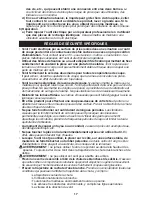
4. The completion of charge is indicated by the green LED remaining on continuously.
The pack is fully charged and may be used at this time or left on the charger.
Recharge discharged batteries as soon as possible after use or battery life may
be greatly diminished. For longest battery life, do not discharge batteries fully. It is
recommended that the batteries be recharged after each use.
Leaving the battery in the charger
The charger and battery pack can be left connected with the green LED glowing
indefinitely. The charger will keep the battery pack fresh and fully charged.
Important Charging Notes
1. Longest life and best performance can be obtained if the battery pack is charged
when the air temperature is between 65°F and 75°F (18°- 24°C). DO NOT charge the
battery pack in an air temperature below +40°F (+4.5°C), or above +105°F (+40.5°C).
This is important and will prevent serious damage to the battery pack.
2. The charger and battery pack may become warm to touch while charging. This is
a normal condition, and does not indicate a problem. To facilitate the cooling of the
battery pack after use, avoid placing the charger or battery pack in a warm environment
such as in a metal shed, or an uninsulated trailer.
3. If the battery pack does not charge properly:
a. Check current at receptacle by plugging in a lamp or other appliance
b. Check to see if receptacle is connected to a light switch which turns power off
when you turn out the lights.
c. Move charger and battery pack to a location where the surrounding air
temperature is approximately 65°F - 75°F (18°- 24°C).
d. If charging problems persist, take the tool, battery pack and charger to your
local service center.
4. The battery pack should be recharged when it fails to produce sufficient power on
jobs which were easily done previously. DO NOT CONTINUE to use under these
conditions. Follow the charging procedure. You may also charge a partially used pack
whenever you desire with no adverse affect on the battery pack.
5. Foreign materials of a conductive nature such as, but not limited to, steel wool,
aluminum foil, or any buildup of metallic particles should be kept away from charger
cavities. Always unplug the charger from the power supply when there is no battery
pack in the cavity. Unplug charger before attempting to clean.
6. Do not freeze or immerse charger in water or any other liquid.
WARNING:
Shock hazard. Do not allow any liquid to get inside charger. Never
attempt to open the battery pack for any reason. If the plastic housing of the battery
pack breaks or cracks, return to a service center for recycling.
This Class B digital apparatus complies with Canadian ICES-003. This device complies
with part 15 of the FCC rules. Operation is subject to the following two conditions: (1)
This device may not cause harmful interference, and (2) this device must accept any
interference received, including interference that may cause undesired operation.
NOTE: This equipment has been tested and found to comply with the limits for Class
B digital device, pursuant to part 15 of the FCC Rules. These limits are designed to
provide reasonable protection against harmful interference in a residential installation.
This equipment generates, uses and can radiate radio frequency energy and, if not
installed and used in accordance with the instructions, may cause harmful interference
to radio or television reception, which can be determined by turning the equipment off
and on, the user is encouraged to try to correct the interference by one or more of the
following measures:
. Reorient or relocate the receiving antenna.
. Increase the separation between the equipment and the receiver.
. Connect the equipment into an outlet on a circuit different from that to which the
receiver is connected.
. Consult the dealer or an experienced radio/TV technician for help.
ASSEMBLY INSTRUCTIONS
INSTALLING AND REMOVING THE BATTERY
PACk FROM THE TOOL
WARNING:
Make certain the lock-off button is engaged to prevent switch actuation
before removing or installing battery.









































